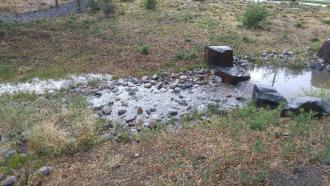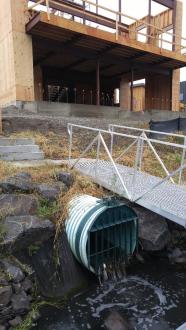Storm Water and Gardening
Submitted by Shannon Erickson on Fri, 2016-06-24 00:00
Today was our last day of adventure learning. We have had a wonderful week so far and have learned so much. Make sure you read all the blog posts to check out the information we got this week. Today started with a presentation from Kim Harrington with the City of Coeur d'Alene, and Laura Winter, an engineer working with the local highway districts, about managing storm water. First it's important to identify what storm water is. Storm water comes from rain or snow melt tthat may infiltrate into the soil or runs off land and hard surfaces. Storm water runoff can pick up pollutants and discharge into our lakes, streams and rivers. Kim showed us an automated monitoring station on a storm water hard pipe in southwest CdA that drains several square miles northeast of NIC that discharges into the Spokane river. The monitoring station measures water flow continuously, and water samples are removed 4 times a year for Zn, Pb, P, N, water hardness, PCB's, and total suspended solids are measurements. Each time these measurements costs $700! Another monitoring site is on the East side of CdA near the golf course. Storm water in the older part of CdA south of I-90 is collected by a hard pipe system and sent to lake Coeur d'Alene, while the northern newer part has a system of bioswales such as grassy swales and other water collection areas that allow infiltration of storm water into the local aquifer. It also includes storm drains that go to buried dry wells that allow drainage into the aquifer. This aquifer has a very high rate of flow. In both cases, waste water and storm water are handled separately, unlike Spokane, which has a combined wastewater and stormwater system. The advantage of a combined system is that all effluent water is treated by a wastewater treatment plant, that can remove pollutants from sewerage pipes that handle storm water. The disadvantage is that in a major storm, overflow water includes untreated sewage. Yuck! Having a separate system means that spills of fertilizer, gas and biodiesel, etc. onto streats go straight into the lake. Kim also told us that fact was part of the reason that stormwater drainage regulation will tighten up to be closer to wastewater regulations. Some suggestions to be a good citizen include: 1. Pick up pet waste, 2. Don't litter (especially cigarette butts), 3. Use car wash facilities, 4. Walk, bike, carpool, 5. Plant native plants, 6. Report polluters.
Afterward, we went to a community garden between an older industrial area and North Idaho College called Community Roots Gathering Garden. Janet Torline talked about the history of the project. It started as a Community Supported Agriculture (CSA) project, but morphed into community gardens within city limits. The most advanced is at 10th and Foster in CdA. This site is called Little She and it collects the produce from the Saturday market that isn't "good enough", distribute the food into boxes and distributed to different food assistance facilities. Janet went through the progression of their garden and the diverent eco-friendly practices that they use. They use solar panels, bio-remediation, recycled materials, sheet mulching, water reuse, nitrogen fixing plants, composting and wood biomass, companion planting and two green houses. Check them out on the garden tour that is coming up! Adrienne Cronebaugh then talked about storm water infiltration in raingardens and bioswales, which perform bioremediation and water purification in addition to absorbing storm water, unlike grassy swales. She also mentioned innovative uses for an older technology. Floating treatment wetlands have been used in water treatment plants for over 50 years as a "polishing step" after earlier treatment steps. They tested a floating treatment wetland at Lake Fernan in 2015. It has as a core 6 inch thick mat of extruded recycled plastic as a matrix to hold vegetation together. A thin layer of coconut coir was laid on top of the mat to bind phosphorus. Next, a layer of grassy sod goes on top. Holes are drilled for plants in the mat and sod, and backfilled with the coir. The resultant mats were about 5 foot square. They were made at the beginning of summer and monitored over the next few months. The wetlands unfortunately were heavily grazed. Some mats that escaped the grazing functioned well as habitat for aquatic organisms, but did not remove as much phosphorus as hoped. One problem that may have limited the effectiveness of the trial at Lake Fernan is that coverage of the floating gardens are recommended to be at least 2% of the water body (and perhaps 30% at this lake), which would be very expensive.
What a day we have had! We have finished up the week but capping what we have done and how we can apply it into the classroom. Hopefully we can help in spreading the word about the ecosystems in ours and the surrounding water shed. And ultimately get students involved so they can make a difference now and in the future! Check out the Boise adventure learning blog coming up July 11th - 15th to get even more information!
Written Shannon Erickson and Bruce Mobarry



Comments
So informative!!
So informative!!
Riparian habitats and urban forests
It sounds like you guys had an information packed day. A few things I took away from the forestry tour I was on this week were the ecosystem services offered by urban forests and riparian habitats around watersheds. We need to be mindful that urban forests not only offer recreation and wildlife habitat, but also offer a source of oxygen creation, nutrient cycling, and most importantly fresh water filtration. As urban forests are removed and covered in asphalt, the likelihood of flooding increases and storm water has less of a chance of being filtered of major contaminants before it hits a water shed.
The decreased riparian buffer zone around Fernan Lake has been a major factor in the phosphate concentration, and increased sediment load in the lake. This has selected for Cyanobacteria proliferation and increased hematoxin concentrations as temperatures have increased.
As our city grows, we need to be focused on healthy sustainable natural resources rather than the financial side of things. The bio-swales and rain gardens are great substitutes for urban forests, It is upsetting to see so many trees in our city being cut down but I guess there is little choice when our population is exploding and there is opportunity for money to be made.
Incredible Facts and Information
That is very interesting in learning how drainage from our city (Coeur d'Alene) results in untreated run-off directly into the lake. I would be interested to learn more about Fernan Lake, and what will hopefully be done in cleaning up both lakes for future generations. Improvements can start now, and will hopefully be continued. There are some really great learning opportunities for students in understanding how our city functions, and what can be done in terms of recycling and treating possible pollutants. Great post!